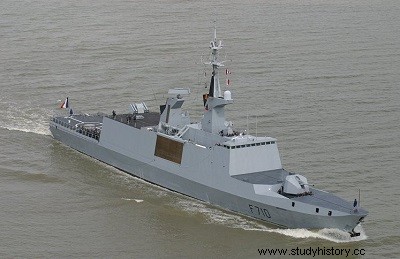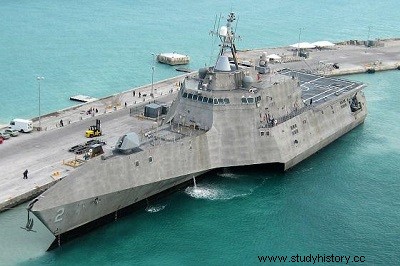
In the modern navy, a frigate protects a precious building (aircraft carrier, projection and command building, nuclear submarine), anti-ship warfare, anti-submarine or anti-aircraft warfare, surveillance of a maritime zone...
The word frigate refers to very different types of ships, it originated in the Mediterranean, and has remained very similar in several languages (fregata in Italy, fragata in Spanish and Portuguese, frigate in English, Fregatte in German).
In modern military terminology, a frigate is a medium-sized surface warship, whose dimensions, weapons and equipment allow it to:
to sail offshore in all weather conditions;
to attack and defend against submarines, aircraft or other ships;
possibly to attack land targets;
to act alone or within a naval force.
In NATO navies:
– the hull number of frigates is preceded by an “F”;
– the coded designation is “FF”, “FFG” (equipped with surface-to-air missiles), “FFH” ( helicopter carriers).
In the French Navy, frigates are classified into 2 categories. 1st rank Georges Leygues, Cassard or "Horizon" type frigates (Forbin and Chevalier Paul) considered as destroyers (letter D, normally associated with destroyers) and second rank, Lafayette or Germinal class (letter F).
Their tonnage is between 2,000 and 7,000 tons; smaller, we talk about corvettes or patrol boats; larger and more versatile cruisers.
After the steam made its appearance (1840-1860), the steam frigates were then the fastest boats. With the systematization of armor, they finally evolved into cruisers at the end of the 19th century, the term falling into disuse.
The term "frigate" reappeared in the British navy during the Second World War to designate ships larger than corvettes, but smaller than destroyers, and responsible for escorting convoys. These ships mainly had anti-submarine armament and equipment, leaving aside the armament for combating surface ships, in particular, torpedoes. They were slower than the destroyers, because they mainly escorted cargo convoys that traveled at less than fifteen knots, but also more enduring, especially when the seas were rough, because they had to fulfill their mission over the entire length of the Atlantic. In their missions and characteristics, they closely resembled US Navy escort destroyers.
Modern frigates
The appellation of frigate has become roughly interchangeable with that of destroyer, depending on the traditions of the various navies.
In the 1960s and 1970s, the introduction and subsequent generalization of anti-ship and anti-aircraft missiles revolutionized their line. Following a trend towards specialization of roles, inherited from the Second World War (with squadron escorts), they became ships specialized in anti-submarine or anti-aircraft warfare tasks, while retaining anti-submarine capabilities. -ships (thanks to artillery and sea-to-sea missiles like the Exocet). Most modern frigates carry helicopters, which are used for anti-submarine or anti-ship warfare (with air-to-sea missiles), reconnaissance, rescue or liaison.
Between 1950 and 1970, certain navies, in particular the French Navy and the US Navy, built the first multi-purpose missile-launching ships under the name of frigates, such as the Suffren and Duquesne, the first French missile-launching frigates launched in 1963 and 1964 which move 6,000 t at a speed of 34 knots. Anti-submarine frigates, such as the Tourville class, are equipped with active or passive sonars, hull or towed, torpedoes, and torpedo-carrying missiles. They also embark helicopters, themselves equipped with dipped sonars, acoustic buoys and torpedoes.
The evolution of the construction of frigates has allowed the appearance of stealth frigates equipped with anti-missile capabilities (such as the La Fayette class equipped with the Crotale missile, or the Horizon class equipped with the ASTER missile. Their geometric shapes have been made to minimize the reflection of radar waves.The modest escort frigates at their origin became at the beginning of the 21st century with the Horizon class the most powerful surface combat vessels in Europe after the aircraft carriers, by improving the technology of processing the radar signal, automation and management of combat systems as well as anti-aircraft and anti-missile missiles, capable of ensuring their self-defense and the protection of a naval force up to a distance of 180 km against buildings surface, 100 km against aircraft and several tens of km against submarines, to control the airspace of a maritime or land area up to a distance of more than 400 km and over 360°.

Finally, the first six Franco-Italian FREMM type frigates will be equipped of MDCN cruise missiles making from May 19, 2015 the French Navy the second Navy with the US Navy having an attack capability against land from a surface building.
